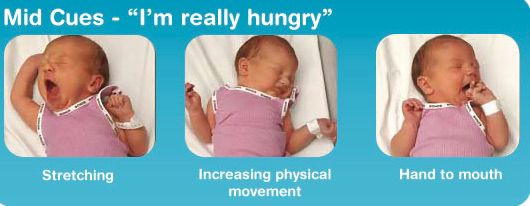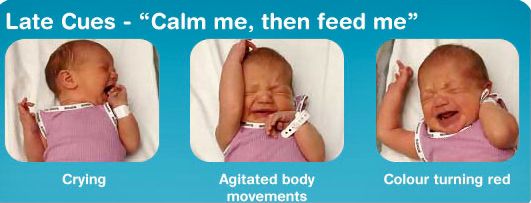- Your baby may feed better if you are lying down and in skin contact.
- If still reluctant to feed we will show you how to hand express your colostrum and give it to your baby. This can be repeated every hour or so.
- Your baby will not need formula unless medically indicated.
Learning to Breastfeed your Baby - The first few days
First few hours
- Keep your baby in skin to skin for as long as possible, until after the first breast feed, and any other time you would like.
- Your baby may “self-attach” if you don’t wash your breasts until after the second feed.
- Ask for help whenever you need.
- Your baby should be offered a second feed within 6 hours.

Feeding cues
Baby will stir, look around, stretch, yawn and suck fingers.

It’s usually easier to feed your baby when they’re calm so it’s really useful to recognise their ‘early feeding cues’ – signals that they’re hungry – which they normally show before they start crying.

Crying is the last sign of hunger and by then baby maybe too distressed to feed effectively.
Time to calm your crying baby
- Cuddling
- Skin contact
- Talking
- Stroking

- Have baby in a straight line, and held very close to you.
- Bring baby up from below, until the baby’s nose is level with your nipple. He/she should be able to see your face.
- Your baby will have a wide mouth. Their cheeks should be round and the nose will be free and unobstructed.
- Your nipple is as round as a cherry on an iced bun when baby comes off the breast. It should not be painful.
- Baby’s first sucks are short, shallow and fast. After 10-30 sec’s they will change to long deep, regular sucks usually 1-2 per swallow. This is best seen below the baby’s chin. Your baby will feed until he comes off the breast spontaneously. He should be winded, have a nappy change and then offered the second breast.
- If baby won’t feed properly or comfortably, try lying down to feed.
- Feed your baby frequently for as long as he wants, breastfeeding will also comfort your baby.
- If baby is reluctant to feed hand express and give expressed milk via a syringe.
- Keep your baby close. Babies can feed up to 12 times in 24 hours and Never less that 7-8 times. Count the number of feeds not the hours.
- Babies feed when they are hungry for as long as they want. They cannot be “overfed or spoiled”. A sleepy baby may need more help.
- Using dummies or bottle teats can make it more difficult for the baby to breast feed.
- Your baby will have bright yellow poo 2-4 times a day, by 5-7 days of age, if feeding well.
- You can ask your midwife, maternity unit, health visitor and local breastfeeding groups, for help to learn to breastfeed if you are finding it difficult.




